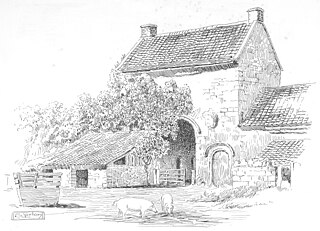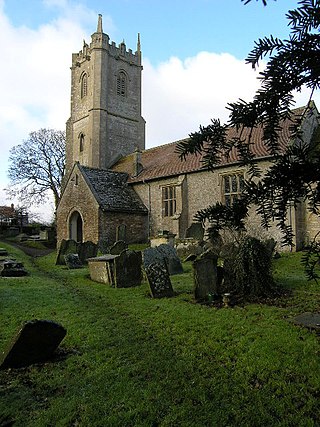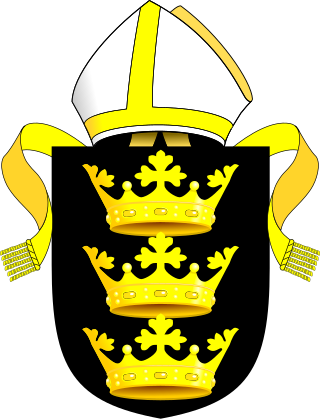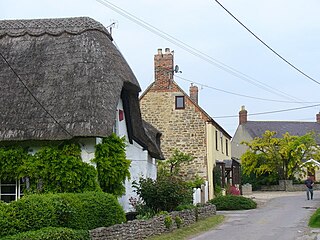
Alveston is a village, civil parish and former royal manor in South Gloucestershire, England, inhabited in 2014 by about 3,000 people. The village lies 1 mile (1.6 km) south of Thornbury and 10 miles (16 km) north of Bristol. Alveston is twinned with Courville sur Eure, France. The civil parish also includes the villages of Rudgeway and Earthcott.

Olveston is a small village and larger parish in South Gloucestershire, England. The parish comprises the villages of Olveston and Tockington, and the hamlets of Old Down, Ingst and Awkley. The civil parish population at the 2011 census was 2,033. Alveston became a separate church parish in 1846. The district has been inhabited since the Stone Age, and the salt marshes that made up almost half of the parish, were progressively drained in Roman and Saxon times. A sea wall was constructed at the same time to prevent flooding from the nearby estuary of the River Severn.

Catmore is a civil parish and village in West Berkshire about 5+1⁄2 miles (9 km) southeast of Wantage. Catmore is in the Berkshire Downs and the centre of the village is about 575 feet (175 m) above sea level.

Walton-on-the-Hill is a village in the Reigate and Banstead district, in the county of Surrey, England. It is midway between the market towns of Reigate and Epsom. The village is a dispersed cluster on the North Downs centred less than one mile inside of the M25 motorway. The village hosts the Walton Heath Golf Club, whose former members include King Edward VIII, Winston Churchill and David Lloyd George.

Abson is a small village in South Gloucestershire, England, it forms part of the civil parish of Wick and Abson.

Pucklechurch is a civil parish in South Gloucestershire, England, the main settlement of which is the large village of Pucklechurch. The parish also incorporates the hamlet of Shortwood to the west of Pucklechurch village, and Parkfield to the north-west. It has a current population of just over 3200 based on the 2021 census data. The village dates back over a thousand years and was once the site of a royal hunting lodge, as it adjoined a large forest.

The Diocese of Bristol is an ecclesiastical jurisdiction or diocese of the Church of England in the Province of Canterbury, England. It is based in the city of Bristol and covers South Gloucestershire and parts of north Wiltshire, as far east as Swindon. The diocese is headed by the Bishop of Bristol and the Episcopal seat is located at the Cathedral Church of the Holy and Undivided Trinity, commonly known as Bristol Cathedral.

Kingswood or Kingswood with Burgh Heath is a residential area on the North Downs in the borough of Reigate and Banstead in Surrey, England. Part of the London commuter belt, Kingswood is just to the east of the A217 separating it from Tadworth and has a railway station. Burgh Heath in its north is combined with it to form a ward. Reigate is 3.6 miles (5.8 km) south of its centre and London is 15.5 miles (24.9 km) to the north northeast. Kingswood with Burgh Heath had a population of 6,891 in 2011.

Oldland is a village and civil parish in South Gloucestershire, England. The parish includes the villages of Cadbury Heath and Longwell Green, and part of Willsbridge. It does not include Oldland Common, which is in the parish of Bitton.

Purleigh is a village on the Dengie peninsula about 4 miles (6.4 km) south of Maldon in the English county of Essex. The village is part of the Purleigh ward of the Maldon district.

Shrewton is a village and civil parish on Salisbury Plain in Wiltshire, England, around 6 miles (9.7 km) west of Amesbury and 14 miles (23 km) north of Salisbury. It lies on the A360 road between Stonehenge and Tilshead. It is close to the source of the River Till, which flows south to Stapleford.

Siston Brook rises in two separate streams which issue from a ridge just north of the village of Siston, South Gloucestershire, England. The brook is approximately 6 miles (9.7 km) long and is a tributary of the Bristol Avon. Much of its course is through the eastern suburbs of Bristol, although it remains outside the city boundaries. Tributaries include the Warmley Brook and an unnamed tributary from Bridgeyate.

Hinton Parva, also known as Little Hinton, is a village in the Borough of Swindon in Wiltshire, England. It lies about 2 miles (3.2 km) from the eastern edge of the Swindon built-up area, and is separated from the town by farmland and the village of Wanborough. The village has a Grade I listed church which has Norman origins. Hinton Parva was a separate civil parish until 1934, and is now in the parish of Bishopstone.

Sir Maurice Denys (1516–1563) of Siston Court, near Bristol, Gloucestershire, and of St John's Street, Clerkenwell, Middlesex, was an English lawyer and property speculator during the Dissolution of the Monasteries, at which time he served as a "powerful figure at the Court of Augmentations". He served as a Member of Parliament for Malmesbury in Wiltshire and as Treasurer of Calais. He was the builder of Siston Court in Gloucestershire, which survives largely unaltered since his time. His excessive speculation and borrowing caused the ruination of the Siston branch of the Denys family.

Sir William Denys of Dyrham, Gloucestershire, was a courtier of King Henry VIII and High Sheriff of Gloucestershire in 1518 and 1526. The surname is sometimes transcribed as Dennis.

Henry Dennis was High Sheriff of Gloucestershire in 1629. He was lord of the manor of Pucklechurch, Gloucestershire. The Dennis family produced more Sheriffs of Gloucestershire than any other family. Like many members of the Gloucestershire gentry he refused to take a knighthood at the coronation of King Charles I in 1625, for which he paid a composition of £25.

Holcombe Burnell is a civil parish in the Teignbridge district, in Devon, England, the church of which is about 4 miles west of Exeter City centre. There is no village clustered around the church, rather the nearest village within the parish is Longdown. Only the manor house and two cottages are situated next to the church. The former manor house next to the church is today known as Holcombe Burnell Barton having subsequently been used as a farmhouse. The manor was in the historical Hundred of Wonford. In 2011 the parish had a population of 536.
Manor of Siston is the ancient manor in Siston in South Gloucestershire, England.
The Denys family of Siston, also spelled Dennis, originally came from Glamorgan in Wales and in the late 14th century acquired by marriage the manor of Siston, Gloucester and shortly thereafter the adjoining manor of Dyrham. Maurice Denys re-built Siston Court in the 16th century.

Uplowman is a village and civil parish in the Mid Devon district, in Devon, England, situated about 4 miles north-east of the town of Tiverton. The parish is surrounded, clockwise from the north, by the parishes of Hockworthy, Sampford Peverell, Halberton, Tiverton, and Huntsham. It is situated near the River Lowman, and further downstream, to the west, is Crazelowman. In 2011 the parish had a population of 331.























